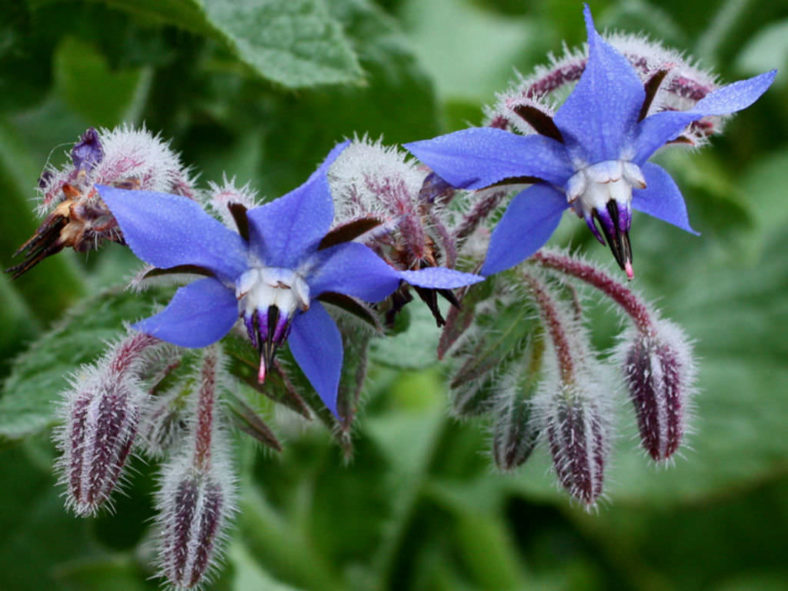Borage (Borago) is a freely seeding, easy-growing annual plant with vivid blue flowers and leaves with the flavor of cucumbers. It is considered an herb but is often grown as a flower in vegetable gardens. It attracts pollinating bees and is regarded as a good companion plant for tomatoes, squash, and strawberries. It's even supposed to deter tomato hornworms and improve the flavor of tomatoes growing nearby.
Borage can bloom from late spring through summer. Staggering your planting times will give you a longer bloom period and provide a longer harvest time.
Borage is a somewhat gangly plant, but you barely notice it because the star-shaped flowers are so vibrant. They're a true blue, hanging in downward-facing clusters. Even the fuzzy white buds are attractive. Both the flowers and the leaves are edible, with a cucumber-like flavor. Use the leaves while young because as the plant matures, the stalks and leaves become covered with a prickly fuzz.
Design Suggestions
Borage is often grown in the vegetable or herb garden because it is such a bee magnet and is considered an excellent growing companion for other plants. However, it is equally beautiful in a cottage-style flower garden, where it has room to self-seed. Harvesting or deadheading will keep it in bloom longer.

Growing Tips
Borage grows best if direct-seeded. Barely cover the seeds with soil and keep them well-watered. They are tolerant of any soil, even poor dry soil. However, a sunny location with fertile, well-draining soil is optimal.
If you choose to start seedlings, transplant them before they become pot-bound. Plan to start seedlings about 3-4 weeks before the last expected frost, and don't transplant outdoors until the soil has warmed. Transplant once seedlings are about 2 to 3 inches (5 to 7.5 cm) tall, thin to approximately 12 inches (40 cm) apart.
Maintenance: Plants in poor soil will benefit from periodic feeding with any fertilizer labeled for edible plants. Something with a high phosphorous (the middle number on a fertilizer package) will help keep them in flower. Plants can be pinched or pruned to encourage branching and keep them shorter.
Harvesting: Harvest leaves and flowers as needed. Older leaves will get prickly, making harvesting anything on the plant a bit unpleasant. However, the flowers add a bit of flavor and a great deal of color to salads, soups, dips & spreads, open-face sandwiches, beverages, and ice cubes. Use them sparingly, as with all edible flowers, until you know how they affect you. Borage is said to have a mild laxative effect.
Borage is open-pollinated, and it is very easy to collect and save the seed from flowers allowed to remain on the plant and turn brown. Borage self-seeds readily if allowed to go to seed naturally. Excess plants are fairly easy to remove from the garden.
Source: about.com
Links
- Back to genus Borago
- Plantpedia: Browse flowering plants by Scientific Name, Common Name, Genus, Family, USDA Hardiness Zone, or Origin

